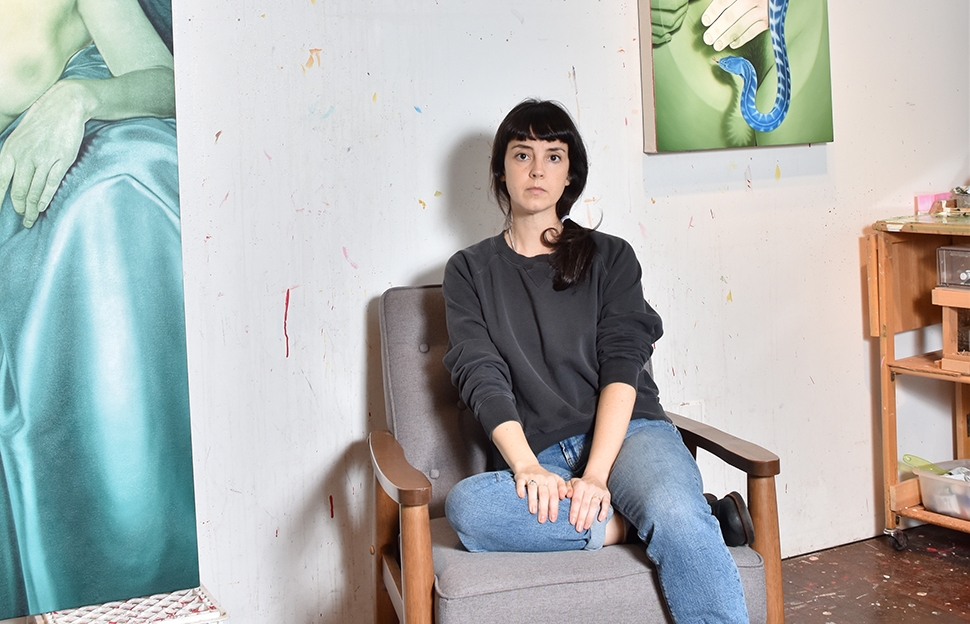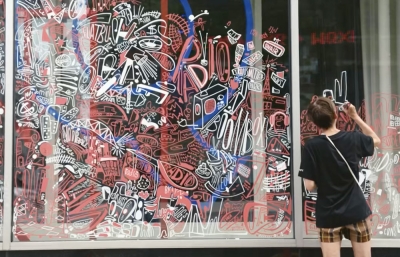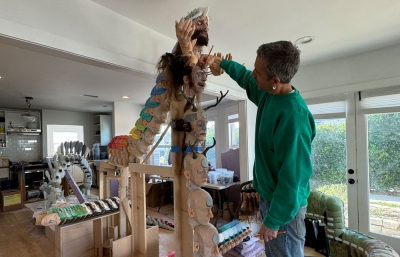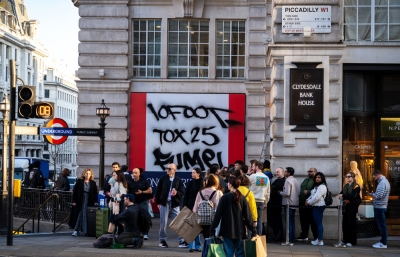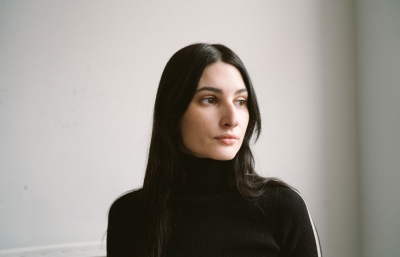Jenny Morgan
A Quiet Reappearance
Interview by Doug Gillen and Evan Pricco and Portrait Courtesy of the Artist
It seems incongruous to be talking to a self-described hermit on a hotel rooftop in South Beach during the biggest art fair week in the world. Sun is out, the ocean crashing in the distance and there is a palpable buzz on the street below. In the lobby, there is an installation of over 170 black-and-white drawings celebrating 25 years of Juxtapoz, among them, the work of New York-based Jenny Morgan, a cover artist on both our magazine and book series, whom we haven’t heard from in a while. Perhaps this is a quiet reappearance, but it is one nonetheless, for Morgan has been doing much self-reflection over the past few years and is ready to talk about how these internal dialogues took shape.
In the time since we last spoke with her, the idea of the figure, body and self-portrait has undergone its own evolution. The politics of the form has taken on new meaning, and for Morgan, it started to change when she saw over 10 years of work hanging at her SKINDEEP retrospective at the MCA Denver in 2017. This isn’t the story of retreat, but how an artist redefined purpose and spent more time internalizing craft at an apex in their career. Here, in her first interview since that Denver show, Radio Juxtapoz’s Doug Gillen and I talk to Morgan about her relationship with the self-portrait, feminism and the power of saying no. —Evan Pricco

Evan Pricco: You mentioned earlier that this is your first interview in three years, and that you’ve been a bit of a hermit. What does reclusiveness mean for you right now?
Jenny Morgan: I wanted to feel less visible in the world, which is a weird sensation when you're an artist because that's kind of the point, to be visible. So I've been craving invisibility, in a sense. I needed to go deep into my practice and work through some stuff. I knew I was transitioning through ideas, and it's hard to do that with a lens on you.
Doug Gillen: Have you just been kind of like logging off of everything, or have you just been saying no to events?
I've been saying no to things…
DG: How does that feel? Everyone writes books about the power of yes.
I think it's an internal decision and there's power in saying no when you're not ready for something and being comfortable with that. But now I'm in a yes phase, because I need to push through some boundaries and comfort zones.

DG: How has that experience gone?
Actually, it feels pretty natural. I think that I'm in a place internally where I'm ready to be social and present, and feel more secure with myself. I think that when you go through a process of transition and looking at your practice, you're actually looking at yourself in a lot of ways.
I think this all relates to my SKINDEEP museum exhibition in Denver. The curator organized it in terms of being a retrospective, and that felt like a milestone. I did my undergrad in Denver, so it was 10 years of work, and seeing it laid out like that felt like a natural cycle was turning over, and my relationship to the self-portrait was changing. I've processed a lot through the action of painting myself, but have moved past that desire, and I don't need to focus there anymore. I don't need the mirror. The self-portrait was always a real safe space. Because I work with portraiture, specifically with people I know, there is an intimacy and a responsibility with everyone that I feel inherently protective of, even though I try to unleash my full creative power and paint something truly authentic. The relationship to the subject is really profound. And so, with friends, I would find myself creating guardrails in the ways I wanted to alter their image because I respected them and did not want to distort them in some way.
So the self-portrait was a space where I could do whatever I wanted, and it didn't matter, because it was my own face and my own space. A lot of my practice is therapeutic and about processing things on a personal level. I got to a point where I didn't need to see that so directly. It's been complex to weave through.
EP: When you're actually in that zone in the studio, do you have a certain day-to-day routine that kind of ensnared you for the past three years?
The routine is more about being a workaholic, I think. I try to get to the studio five or six days a week, and that's where I go and process life. I'm very, very obsessed with trying to make a painting that feels better and more resolved. So it's a constant goal to get to the next piece that resolves this other inner thing. It’s a bit cyclical. I often consider psychomagic and the act of taking an image that might be intense or personally triggering, and manipulating it in a way resolves something internally. I think that's where the magic lies in making art. That's always the purpose: to get in there.

The Devotional, Oil on canvas, 70” x 48”, 2020
DG: Do you find a conflict in the way art can be therapeutic and help you work through your personal life, or something you're trying to internalize as you create something tangible from it?
Yes, that's the reason for being a hermit for three years. There was a conflict there, a schism. I recently read a quote and I can't remember who it was to give them credit, but the artist spoke about how making work means constantly working on yourself and your wounds, but that also means you’re constantly exposing those wounds to the world. And so, I think I got to a place where I just… I mean, part of working with a self-portrait is also about knowing that you're able to disassociate from your body, like we all do at times. The self-portraits end up being a way to kind of get back into your body. That's always been a goal for me. And at some point, I did snap back into my body, and then, when I saw myself externalized, I became aware that I was hanging naked on a wall. It was an awareness that vibrated through me that I hadn't experienced before, and I could no longer disassociate. I think I really was processing how exposed I was.
EP: Have you read similar things and felt kinship about the way artists throughout history have looked at their self-portrait work? Was it necessary to learn what other people had gone through?
Joan Semmel, in particular, was important for me to look at because much of her work is painted from the perspective of her own body. It's not an outside lens looking; she’s looking at herself, and also how she transitions through her life and body changes. She's still making this work and she's in her eighties, documenting her body through space and time. I'm still thinking about all that content.
EP: So, would we be surprised by this new work you’re making?
Not surprised. I think I've always had a deep connection to the lineage of figuration and a very complex relationship to its history. And right now, for the first time, I’m working with a few art-historical poses and contexts that I've avoided throughout my career. But now I'm jumping face deep into it—I have to confront it.
I'm working with the Odalisque and I'm in a place where I'm more actively sexualizing the female body. Early on, it was really important for me not to sexualize, and definitely not to objectify. I feel that's why I work with portraiture on an emotional level—I want there to be a soul in the painting and it to not be an object. But, I think, due to where the world is culturally and what's happening politically with the female body, I noticed a shift in the outside perception of the work and the female nude in general. My attempts not to sexualize her kind of fell by the wayside just because of where we are right now. So I wanted to own that sexualization and just feel like I can be in this space and own it, in a way.

Touch Study, Oil on canvas, 17” x 14”, 2019
DG: What you said about not sexualizing it feels like it's almost an oppressive way of constructing something because, you know, you should be able to sexualize anything you want. Maybe that's not politically correct, but if you want to paint a sexualized woman, that should be okay. It shouldn't be off limits because of the way it's been portrayed previously or by other people.
I think that's where my relationship with feminism is changing, or I'm looking at that relationship, because my intent has been not to make a sexual object. There's a whole history with the male gaze and who's looking, and how they feel when they look at it, and what your personal responsibility is for how the viewer feels. I avoided the sexualization just to keep that conceptual space clear. But now I'm okay with all of that being in the same space.
EP: Was this a conversation you had with the models you were working with through the years?
Yeah, absolutely. Because some are friends who have never posed or taken their clothes off for a camera, so it's a different conversation. I have one subject I paint consistently, Syrie, who was the subject on the cover of Juxtapoz back in 2014. She's a professional model and she's comfortable. She's also a close friend, so she gives a different energy because she's aware that she's going to be looked at. Whereas, for a friend who I'm working with right now, it was the first time posing, and I could feel her vulnerability so intensely that I almost feel responsible for putting her out in the world in that way. It actually took me two years to start the painting because I had to work through that sensation, and I wanted to honor that aspect of our relationship.
DG: What atmosphere do you try to create in that moment?
I mean, it's obviously very intimate. Just me and the subject, and it's thrilling. I almost shake with excitement in that moment of photographing someone and being that vulnerable and open. It lets you get to know your friends in a different way, too, that kind of intimacy. A lot of deep conversations happen because you're so vulnerable with each other. You don't end up talking about the weather. You go to some more profound emotional spaces together.
DG: How has this positively or negatively impacted some of your relationships with people?
That's also something that I was processing, as the artist feeling the emotional consequences for the work that you make, which I don't think a lot of people really talk about that openly. I've painted my parents, you know, and it's an interesting thing for them to see how their daughter perceives them.

DG: Do you see a change in the relationship?
Yeah, absolutely. And that's the magic about working with people in your life; you can see these personal dynamics play out, especially looking at work that you've made in the past and then having moments of, “Oh, that's why I did that, and that's where this is coming from.” In seeing the unconscious material that works its way up, you arrive at a conscious moment where you have an intent, and every formal decision becomes an unconscious narrative that's coming through. So, you make these decisions with paint and color, and then, in retrospect, see where that's coming from on an internal level. I think that's the real magic of it all.
DG: You made a comment earlier about how your attitude toward feminism has changed. Can you talk a little bit about that, how you feel now about the movement, the phrase, the terminology?
I personally was deeply affected by the Me Too movement. Growing up in Utah, I could feel the history of suppression and repression, and so that cultural movement of people expressing everything so publicly opened up things for me that drugs, church and spirituality couldn't do. The social aspect was super important. I’m more comfortable owning that word and owning that language and understanding that I'm a woman working with the female body, and that has deep connotations.
EP: As somebody who's taken a step back from art world activity over the last three years, have you allowed yourself a chance to consider whether the art world is heading in the right direction?
I think it's all important. Right now we're talking about identity politics. In recent history, the figure was not supported, and if you came into art school wanting to work with figuration, you were probably directed somewhere else. I felt that personally. And I think now, with identity politics, the figure is hyper-important because it's our bodies. That's where we want to talk through everything. So I understand that the art world's really looking at figuration and dissecting it. I think, right now, we're having a big conversation about boundaries and what they look like in all of these realms, and how to respect people and understand each other. In psychological terms, boundaries create more space for compassion. So it feels like we're blocking things off and putting up guardrails. But I think, for the moment, it might help us to step back and look at these ideas and these voices.

DG: Do you mean that’s healthy or unhealthy?
I mean there's always going to be some unhealthy aspects to it. There's going to be an underbelly or a dark side to everything, but I think the positive intent is there, and a lot of really smart, important thinkers are lifting upwards and bringing all this forward.
DG: Do you feel that the phrase “identity politics” is loaded or divisive?
It's all loaded. Working with a figure is loaded, and I understand that. I feel like I'm the kind of person who can handle all of that baggage. I'll sit down and go through it with you. Like, for fun, let's just talk about it. So that's why I'm okay in this arena. But I know a lot of people who step back because they don't want to carry all of it and talk it through because it is really heavy.
EP: What is lined up at the moment for this new body of work?
I'm going to be doing my next solo show with Mother Gallery in Beacon, New York. I like that it's not directly in the city—something about having to make a journey to go see something feels good to me right now. I’m enjoying working with the owner Paola. The dialogue that we're having about the work is important to me. As with anyone I work with, the dialogue is an influence on the work. I don't know if artists really talk about that enough, the relationship that you have with your dealer and how much that influences your work. I choose to work with people who are going to help me grow in the direction where I want to go. We're having a great conversation and I’m feeling a lot of freedom.
This interview is an excerpt from our Radio Juxtapoz conversation with Jenny Morgan in Miami Beach in December 2019. Morgan’s solo show was to be on view Mother Gallery in Beacon, New York from March 21–April 19, 2020. It has been postponed.

